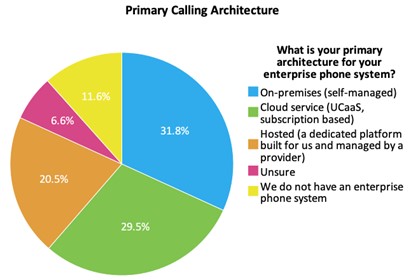While businesses quickly adopted cloud-based conferencing and collaboration services during the pandemic, the same cannot be said about cloud-based calling. The reality is while cloud calling has been in the market for over 15 years, the majority of businesses are still on dedicated PBX solutions. Less than 40% of businesses worldwide have migrated to UC as a Service (UCaaS) and businesses are not moving fast to off on-prem PBXs. According to Metrigy’s MetriCast Workplace Collaboration study, 44% of businesses that are still utilizing on-prem calling have no immediate plans (within at least next 3 years) to migrate to full UCaaS.
For businesses that are in the migration cycle, according to worldwide respondents in the same study, the number one reason for moving to UCaaS is cost savings, followed by supporting a remote workforce, access to enhanced features, and scalability. Conversely, key factors for businesses sticking with on-premises based PBXs include ongoing ROI for voice systems, misconceptions around cloud calling, and competing priorities. As a driving factor on both sides (cloud and on-prem), cost is an important pivot point for switching.
As businesses migrate voice and UC solutions to cloud calling, there continues to be a need to maintain legacy PBX solutions on-premises during the transition to unify their solutions over time. Managing the migration to cloud calling depends on multiple factors but the larger the company the more complicated the transaction. Depending on the size of migration, the move to UCaaS can take months if not years.
Consider a real-life example, a global manufacturing firm with over 30,000 users has multiple, on-prem PBX systems across two different vendors and Microsoft Teams for collaboration and meetings. In 2023, the company started migrating calling to Microsoft Teams through Direct Routing, with a two-year timeframe plan in place.
Key parts of the migration for this specific business include simultaneous management of Teams and on-prem systems, calling continuity across Teams and the on-prem systems, and utilizing an integrator to help manage calling infrastructure across the PBXs and Microsoft Teams.
In the example above, important steps in the migration offer insights for other companies on this path which includes evaluating third-party support. These steps included:
- Putting in place a comprehensive schedule, determining critical phases of migration and key milestones, which may include keeping some PBXs in place longer term.
- Managing current PBXs and related system maintenance remains of high importance with in-house expertise or outsourcing, during the transition. Depending on the age of the PBX, replacement parts and upgrades may be non-existent necessitating a plan to phase older systems quicker.
- Identifying important capabilities which may require customization and/or system integration, including assessing capabilities inside of Teams. Working with partners may be necessary to augment internal resources for complex customization.
- Choosing a partner that will participate in seeing the full technology transition to completion, is important for continuity and ensuring a seamless transition.
For large cloud calling implementations, there will be a period of maintaining two systems with hybrid voice connections, enabling PSTN connectivity between PBX systems and UCaaS solutions. Hybrid calling allows businesses to operate existing PBXs during transition, leverage existing carrier relationships, enable e911 services, and update obsolete endpoints. An important part of a hybrid calling plan is having a proactive security strategy that spans all environments.
While transitioning to cloud calling and maintain older, legacy PBXs and a UCaaS environment, businesses have a few management options to consider in order to:
- Vendor-provided tools: no additional costs, downside is they only support specific vendor’s applications and services and may lack network insight
- Network management tools: typically provide insight into voice/video performance across the network but can lack end-to-end visibility, and additional management functions (administration, security, etc.)
- Third-party tools: typically optimized for workplace collaboration administration and/or management, may interface with or include network management tools, and most importantly enable unified management of a multi-vendor environment.
While much of the attention these days centers on new and enhanced capabilities such as AI, the reality is businesses are still in the middle of fundamental transformation projects, including calling platforms. For most businesses, this transformation will require supporting dual systems for a period to ensure continuity of service, security, and ease of use for end-users.
We anticipate continued migration of calling seats to the cloud in 2024 but it will take years before the scales are tipped in favor of cloud calling. Planning for any transformation project is important but working with the right partner(s) will set the tone for success.
Join us on Tuesday, March 26 at Enterprise Connect for Managing the Migration from On-Prem to the Cloud where we’ll discuss these topics and much more!
Enterprise Connect 2024 will be held at the Gaylord Palms in Orlando, FL, from March 25-28. Preview the conference schedule or register to attend. To keep on top of all Enterprise Connect developments, subscribe to the weekly newsletter.











